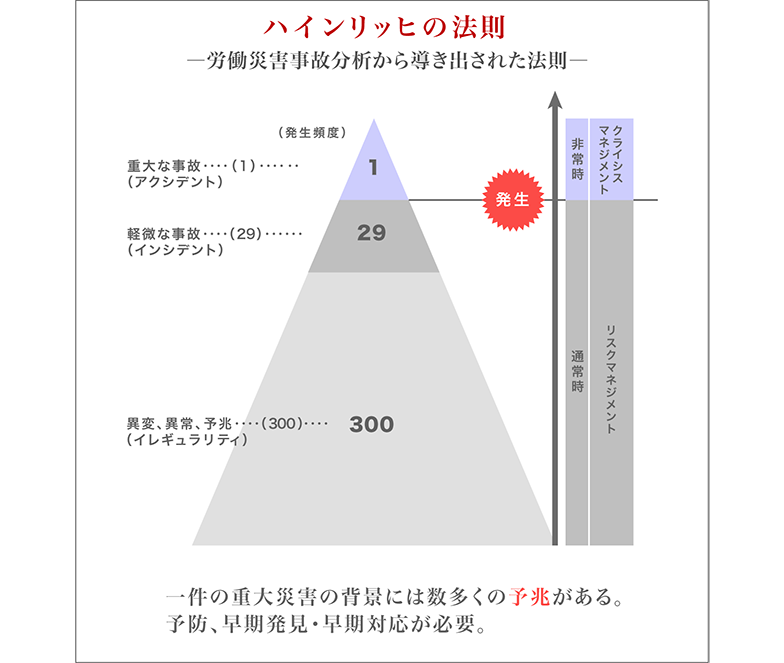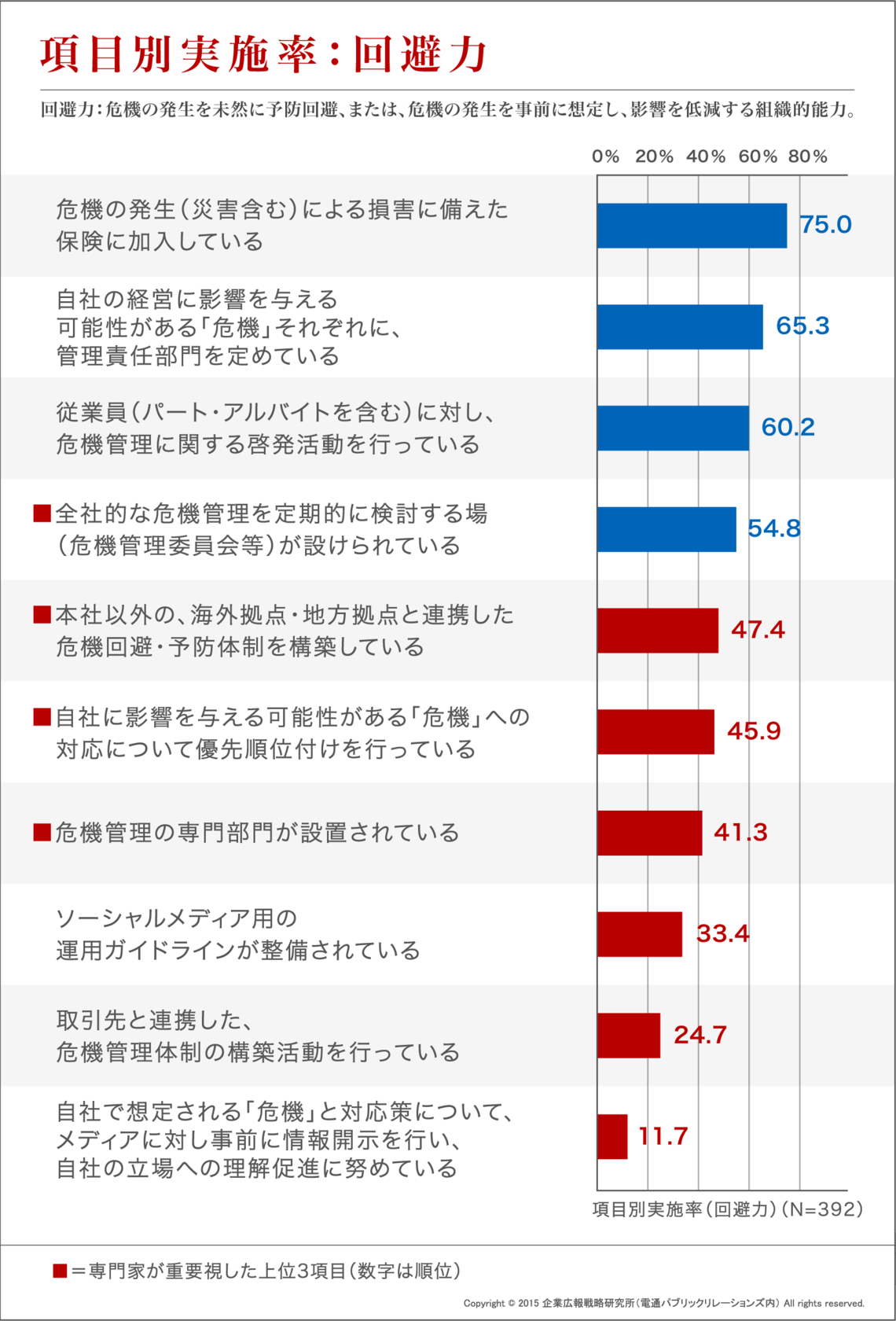At the Corporate Public Relations Strategy Institute, we define "avoidance capability" within crisis management as follows: "The organizational ability to prevent and avoid crises before they occur, or to anticipate crises in advance and mitigate their impact."
To use a car analogy, it's like maintaining a wide field of vision to avoid panicked, sudden braking. Instead, it's about detecting obstacles or people's movements as early as possible and applying the brakes gradually and steadily, like the technique known as pumping the brakes.
More technically, there's the term "active safety." This refers to the collective term for technologies that support safe driving by the driver to prevent accidents before they happen. Examples include technologies that prevent wheel lockup during sudden braking and systems that prevent the car from sliding sideways on curves. Incidentally, the technology domain focused on mitigating harm to occupants in the event an accident does occur is called "passive safety" (collision safety). Seat belts and airbags are prime examples.
Cross-functional sharing of crisis management information is crucial
Now, in the "Crisis Management Capability Survey" conducted by our institute last January, the "avoidance capability" among the "five crisis management capabilities" we've previously introduced showed a relatively high score. Particularly in the "Electricity and Gas" sector, it achieved the highest score among industries at 77 out of 100 points. Among the 10 items measuring this "Avoidance Capability," crisis management experts identified the following four items as particularly important (listed in order of importance):
① A forum (such as a crisis management committee) exists to regularly review company-wide crisis management.
② A dedicated crisis management department is established.
③ A crisis avoidance and prevention system is established in collaboration with overseas and regional bases outside the head office.
④ Prioritization of responses to potential "crises" that could impact the company.
Regarding item ①, the crisis management committee, 54.8% of companies—just over half—have established one. While the committee's role, operational methods, and membership likely vary, it is crucial for crisis management, especially for larger organizations and companies with diverse business areas, to have such a cross-functional forum for sharing information on emerging risks, their manifestation, and misconduct occurring at other companies.
The Two Aspects of "Avoidance Capability"
Avoidance capability can be broadly divided into two aspects. One is taking measures to prevent the seeds of crises (accidents/incidents) from germinating. The other is preparing various countermeasures in case such seeds do germinate or blossom.
To prevent germination, measures include establishing the aforementioned crisis management committee or specialized departments, conducting thorough internal risk (hazard factor) assessments centered around these bodies, translating these findings into a "risk map" for visualization, and issuing warnings.
Risks cannot be completely eradicated. As the well-known "Heinrich's Law" indicates, preventing major scandals that could shake the company's foundations requires detecting precursors or minor anomalies as early as possible and responding/addressing them promptly. These precursors and anomalies are called "near misses" and are invariably covered in crisis management textbooks. This term refers to those small incidents during work that make you think "Whoa, that was close!" or give you a start. Organizations entrusted with human lives, such as hospitals and transportation companies, enforce very strict reporting of these near misses.

It is also crucial to thoroughly understand and prepare for potential violations when relevant laws and regulations are newly enacted, revised, or strengthened. Laws are constantly being amended in response to changes in society and the economic environment. Companies must assess the impact these changes will have on their operations and issue necessary internal alerts. For example, this year marks the full implementation of the "My Number System." Efforts to anticipate risks from every angle regarding its handling are likely underway across various departments right now.
On the other hand, what preparations are needed to guard against crises sprouting or blossoming from the malicious intent of a single individual or the careless mistake of just one person? First and foremost, a "manual" is essential. It is important to incorporate sections like "What to do if an incident or accident occurs" into standard operational manuals, or to establish a dedicated "Crisis Management Manual."
The most crucial aspect of manual creation is ensuring it is usable and effective when needed. To verify this effectiveness, we recommend "simulation training." This involves selecting one risk from those identified, assuming it actually occurs, and then physically and mentally practicing the subsequent actions (response). You don't need to do this frequently, but consider conducting it about once a year, similar to disaster drills. This will reveal issues like "Oh, this part doesn't connect" or "This part was completely overlooked." Additionally, if there have been organizational changes or personnel transfers, you must also maintain reporting routes. Recently, online troubles have also been on the rise, so don't forget to establish operational guidelines for social media and ensure they are thoroughly implemented within the organization.
Don't just go through the motions
As outlined above, implementing measures like establishing a crisis management committee, conducting risk assessments, and creating a crisis management manual are certainly important. However, these are merely necessary conditions. What's most crucial is the "mindset" to genuinely commit to crisis management through these actions. It's like building a statue without putting a soul in it. Crisis management without this mindset is nothing more than a pipe dream. Raising and cultivating awareness is easier said than done, and there is no magic solution. The key lies in everyday internal communication, such as how to make scandals occurring at other companies feel personally relevant.
The head of one company reportedly repeated a single phrase at every opportunity, including all-hands meetings: "100 minus 1 equals zero." This serves as a warning: even if 100 employees work diligently, a single careless mistake by one person can destroy the trust and credibility built by all 100.
Now, "better safe than sorry." How is your company's "risk avoidance capability"?


